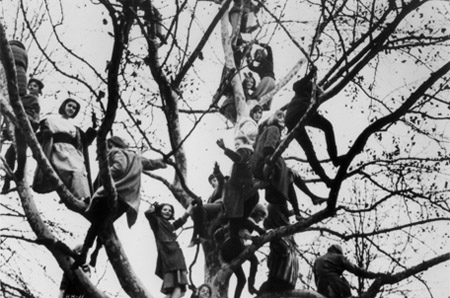“The year begins with a magnificent series at Film Forum, New Yawk New Wave,” writes the New Yorker‘s Richard Brody, sending “kudos to the programmers, Bruce Goldstein and Jake Perlin, and to J. Hoberman, credited with the series concept and as its advisor—which highlights the artistic originality of independent filmmakers in New York in the 50’s through the 70’s. Its insightful selections offer a thesis: the epochal efflorescence of cinematic invention of the French New Wave that burst onto the scene in the late 50’s and early 60’s was matched—and, in some ways, foreshadowed by, and even influenced by—the burst of movie creativity from New York’s independent filmmakers of the era, many of whom (including John Cassavetes, Martin Scorsese, Brian De Palma, Jonas Mekas, and Stanley Kubrick) rank among the most influential and important modern filmmakers.”
At Artinfo, Hoberman himself notes that both New Waves “derive from Italian neo-realism (the original new wave) but Morris Engel‘s 1953, Coney Island set indie Little Fugitive (which postscripts NYNW with a one week run, February 1-7) inspired François Truffaut as well as local filmmakers. Martin Scorsese’s 1973 Mean Streets which ends the show (screening January 30, 31) is the summarizing work (or ‘woik’). Mean Streets drew on nouvelle vague technique—and cinephilia—but, even more, on the key ‘New Yawk’ feature, John Cassavetes’s Shadows (January 12) as well as assimilating underground outliers like Kenneth Anger’s stylized documentary Scorpio Rising (January 25).”
“Spanning the mayoralties of Vincent Impellitteri and John Lindsay,” writes Melissa Anderson in the Voice, “the program not only reveals the vast number of cinema movements bubbling up during this 20-year stretch—whether in documentary, fiction, or a hybrid of the two—but also highlights a new kind of ‘star’: the junkies, freaks, drunks, hustlers, queers, drag queens, and insurrectionists of all colors and professions indigenous to no other metropolis but ours. One of those aforementioned flourishing film movements was the New American Cinema, a collective that coalesced in late 1950s and early ’60s. Members Shirley Clarke—a onetime daughter of Park Avenue privilege who soon abandoned all posh comforts—and brothers Jonas and Adolfas Mekas (whose work also screens in the series) advocated for radical changes in U.S. filmmaking, eventually issuing, along with others, a manifesto that ended with this salvo: ‘We don’t want rosy films. We want them the color of blood.’ Lysergic colors, in fact, dominate Clarke’s kaleidoscopic Bridges-Go-Round, a 1958 short whose kinetic vision of the city is echoed in the black-and-white Skyscraper (1960), a jazzy salute to the Tishman Building on Fifth Avenue co-directed with Willard Van Dyke. Clarke’s impeccable eye for NYC locales also animates The Cool World (1964), about rumbling gangs of African-American teens in Harlem—one of the first fiction features to be shot entirely on location in that neighborhood.”
Time Out New York‘s David Fear notes that “it’s some of the lesser-known entries here that help connect the dots between DIY New Yawk and the nouvelle vague. You don’t get a more blatant example of cross-cultural foreign exchange than Hallelujah the Hills (Jan 24), Adolfas Mekas’s 1963 answer to Franco anarchy that combines silent-comedy slapstick, bizarre love triangles, a dance-off on a cliff and a clip from Griffith‘s Way Down East into one nutso absurdist tangent. The influence of late Godard shows up in many of the leftist-radicalist run-and-gun productions here (see Robert Kramer’s paranoid android of an Alphaville riff, Ice, screening Jan 24–25). Only Mekas’s comedy, however, captures the early free-form spirit of the New Waver and namechecks Breathless to boot.”
“One of the great pleasures and insights of Film Forum’s smorgasbord is seeing sensibilities influencing one another,” writes Nicolas Rapold in the Times. “Before directing his feature [Coming Apart, Milton Moses] Ginsberg did sound work for Robert Frank, also featured in the series, and he credits Jim McBride‘s 1967 David Holzman’s Diary and its self-conscious approach as an inspiration for Coming Apart. Diary presents the audience with a callow filmmaker trying to make art of life, and annoying his girlfriend and others around him in the process. Before becoming a director Mr. McBride wrote a monograph on cinéma vérité for the Museum of Modern Art with the film’s star, L. M. Kit Carson. They interviewed [D. A.] Pennebaker, Albert Maysles, Andy Warhol and others, and became inspired by the seductive practice of shooting live situations. ‘They forget sometimes that the truth lies,’ Mr. McBride said. ‘And somehow thinking about all those kinds of things, we thought about a guy making the film he thought would tell the truth.'”
New Yawk New Wave runs through January 31.
Update, 1/18: Joseph Jon Lanthier in the L on Jack Garfein’s Something Wild (1961): “A lyrically disorienting love letter to New York City—but of the sort that often gets reprinted in the tabloids—this movie was, in spite of its soon-to-be de rigueur brazenness, neither a commercial success nor recognized as a milestone of independent cinema (as John Cassavetes’s Shadows was only months earlier). The reasons aren’t difficult to fathom: though famously frank (Carroll Baker’s naively middleclass, undergrad-protagonist is sexually violated within both the first 15 minutes and the audience’s plain view), the film’s explicitness fails to congeal into anything resembling social realism—or even the issue-conscious theatricality practiced by, say, Elia Kazan or Shirley Clarke. Instead, the movie more daringly treats the blistering shamefulness of its first-act rape as an opportunity to dislodge itself from dramatic convention almost entirely; afterward, all bets are off, and director Garfein nosedives into the long, angular shadows of his main character’s traumatized headspace.”
Update, 1/23: “The New American Cinema began with two Lithuanians.” In the L, Aaron Cutler briefly outlines the contributions of Jonas and Adolfas Mekas and recommends Hallelujah the Hills.
For news and tips throughout the day every day, follow @KeyframeDaily on Twitter and/or the RSS feed. Get Keyframe Daily in your inbox by signing in at fandor.com/daily.





